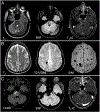Cavernous angiomas: deconstructing a neurosurgical disease
- PMID: 31261134
- PMCID: PMC6778695
- DOI: 10.3171/2019.3.JNS181724
Cavernous angiomas: deconstructing a neurosurgical disease
Abstract
Cavernous angioma (CA) is also known as cavernoma, cavernous hemangioma, and cerebral cavernous malformation (CCM) (National Library of Medicine Medical Subject heading unique ID D006392). In its sporadic form, CA occurs as a solitary hemorrhagic vascular lesion or as clustered lesions associated with a developmental venous anomaly. In its autosomal dominant familial form (Online Mendelian Inheritance in Man #116860), CA is caused by a heterozygous germline loss-of-function mutation in one of three genes-CCM1/KRIT1, CCM2/Malcavernin, and CCM3/PDCD10-causing multifocal lesions throughout the brain and spinal cord.In this paper, the authors review the cardinal features of CA's disease pathology and clinical radiological features. They summarize key aspects of CA's natural history and broad elements of evidence-based management guidelines, including surgery. The authors also discuss evidence of similar genetic defects in sporadic and familial lesions, consequences of CCM gene loss in different tissues at various stages of development, and implications regarding the pathobiology of CAs.The concept of CA with symptomatic hemorrhage (CASH) is presented as well as its relevance to clinical care and research in the field. Pathobiological mechanisms related to CA include inflammation and immune-mediated processes, angiogenesis and vascular permeability, microbiome driven factors, and lesional anticoagulant domains. These mechanisms have motivated the development of imaging and plasma biomarkers of relevant disease behavior and promising therapeutic targets.The spectrum of discoveries about CA and their implications endorse CA as a paradigm for deconstructing a neurosurgical disease.
Keywords: CA = cavernous angioma; CASH = CA with symptomatic hemorrhage; CCM = cerebral cavernous malformation; CD14 = cluster of differentiation 14; DCEQP = dynamic contrast enhanced quantitative perfusion; DVA = developmental venous anomaly; FDR = false discovery rate; MEKK = mitogen-activated protein kinase kinase; QSM = quantitative susceptibility mapping; SRS = stereotactic radiosurgery; SWI/VenBold = susceptibility weighted imaging/BOLD venographic imaging; T2*/GRE = gradient recalled echo acquired; TLR4 = toll-like receptor 4; VEGF = vascular endothelial growth factor; angioma; cavernoma; cavernous; epilepsy; hemangioma; hemorrhagic stroke; sCD14 = soluble form of CD14; sROBO4 = soluble form of Roundabout 4; vascular disorders; vascular malformation.
Figures






Similar articles
-
Vascular permeability and iron deposition biomarkers in longitudinal follow-up of cerebral cavernous malformations.J Neurosurg. 2017 Jul;127(1):102-110. doi: 10.3171/2016.5.JNS16687. Epub 2016 Aug 5. J Neurosurg. 2017. PMID: 27494817 Free PMC article.
-
Correlation of the venous angioarchitecture of multiple cerebral cavernous malformations with familial or sporadic disease: a susceptibility-weighted imaging study with 7-Tesla MRI.J Neurosurg. 2017 Feb;126(2):570-577. doi: 10.3171/2016.2.JNS152322. Epub 2016 May 6. J Neurosurg. 2017. PMID: 27153162
-
Perfusion and Permeability MRI Predicts Future Cavernous Angioma Hemorrhage and Growth.J Magn Reson Imaging. 2022 May;55(5):1440-1449. doi: 10.1002/jmri.27935. Epub 2021 Sep 24. J Magn Reson Imaging. 2022. PMID: 34558140 Free PMC article.
-
Molecular Genetic Features of Cerebral Cavernous Malformations (CCM) Patients: An Overall View from Genes to Endothelial Cells.Cells. 2021 Mar 22;10(3):704. doi: 10.3390/cells10030704. Cells. 2021. PMID: 33810005 Free PMC article. Review.
-
Oxidative stress and inflammation in cerebral cavernous malformation disease pathogenesis: Two sides of the same coin.Int J Biochem Cell Biol. 2016 Dec;81(Pt B):254-270. doi: 10.1016/j.biocel.2016.09.011. Epub 2016 Sep 14. Int J Biochem Cell Biol. 2016. PMID: 27639680 Free PMC article. Review.
Cited by
-
Comprehensive CCM3 Mutational Analysis in Two Patients with Syndromic Cerebral Cavernous Malformation.Transl Stroke Res. 2024 Apr;15(2):411-421. doi: 10.1007/s12975-023-01131-x. Epub 2023 Feb 1. Transl Stroke Res. 2024. PMID: 36723700
-
Functional neurological outcome of spinal cavernous malformation surgery.Eur Spine J. 2023 May;32(5):1714-1720. doi: 10.1007/s00586-023-07640-5. Epub 2023 Mar 16. Eur Spine J. 2023. PMID: 36928489
-
Multiple supra- and infratentorial cavernous hemangiomas in a five year-old girl.Iran J Child Neurol. 2023 Summer;17(3):157-162. doi: 10.22037/ijcn.v17i2.37749. Epub 2023 Jul 1. Iran J Child Neurol. 2023. PMID: 37637788 Free PMC article.
-
Cerebral Cavernous Malformation Proteins in Barrier Maintenance and Regulation.Int J Mol Sci. 2020 Jan 20;21(2):675. doi: 10.3390/ijms21020675. Int J Mol Sci. 2020. PMID: 31968585 Free PMC article. Review.
-
Advances in Mass Spectrometry of Gangliosides Expressed in Brain Cancers.Int J Mol Sci. 2024 Jan 22;25(2):1335. doi: 10.3390/ijms25021335. Int J Mol Sci. 2024. PMID: 38279335 Free PMC article. Review.
References
-
- Abdulrauf SI, Kaynar MY, Awad IA: A comparison of the clinical profile of cavernous malformations with and without associated venous malformations. Neurosurgery 44:41–47, 1999 - PubMed
-
- Akers A, Al-Shahi Salman R, Awad IA, Dahlem K, Flemming K, Hart B, et al.: Synopsis of Guidelines for the Clinical Management of Cerebral Cavernous Malformations: consensus recommendations based on systematic literature review by the Angioma Alliance Scientific Advisory Board Clinical Experts Panel. Neurosurgery 80:665–680, 2017 - PMC - PubMed
-
- Al-Shahi Salman R, Berg MJ, Morrison L, Awad IA: Hemorrhage from cavernous malformations of the brain: definition and reporting standards. Stroke 39:3222–3230, 2008 - PubMed
Publication types
Grants and funding
LinkOut - more resources
Full Text Sources
Research Materials
Miscellaneous

